Managerial Economics ! .
VerifiedAdded on 2023/05/29
|5
|546
|228
AI Summary
This text provides answers to questions related to Managerial Economics. It covers topics such as net present value, investment planning, capital budgeting, price elasticity of demand and more. The text also includes references and bibliography.
Contribute Materials
Your contribution can guide someone’s learning journey. Share your
documents today.
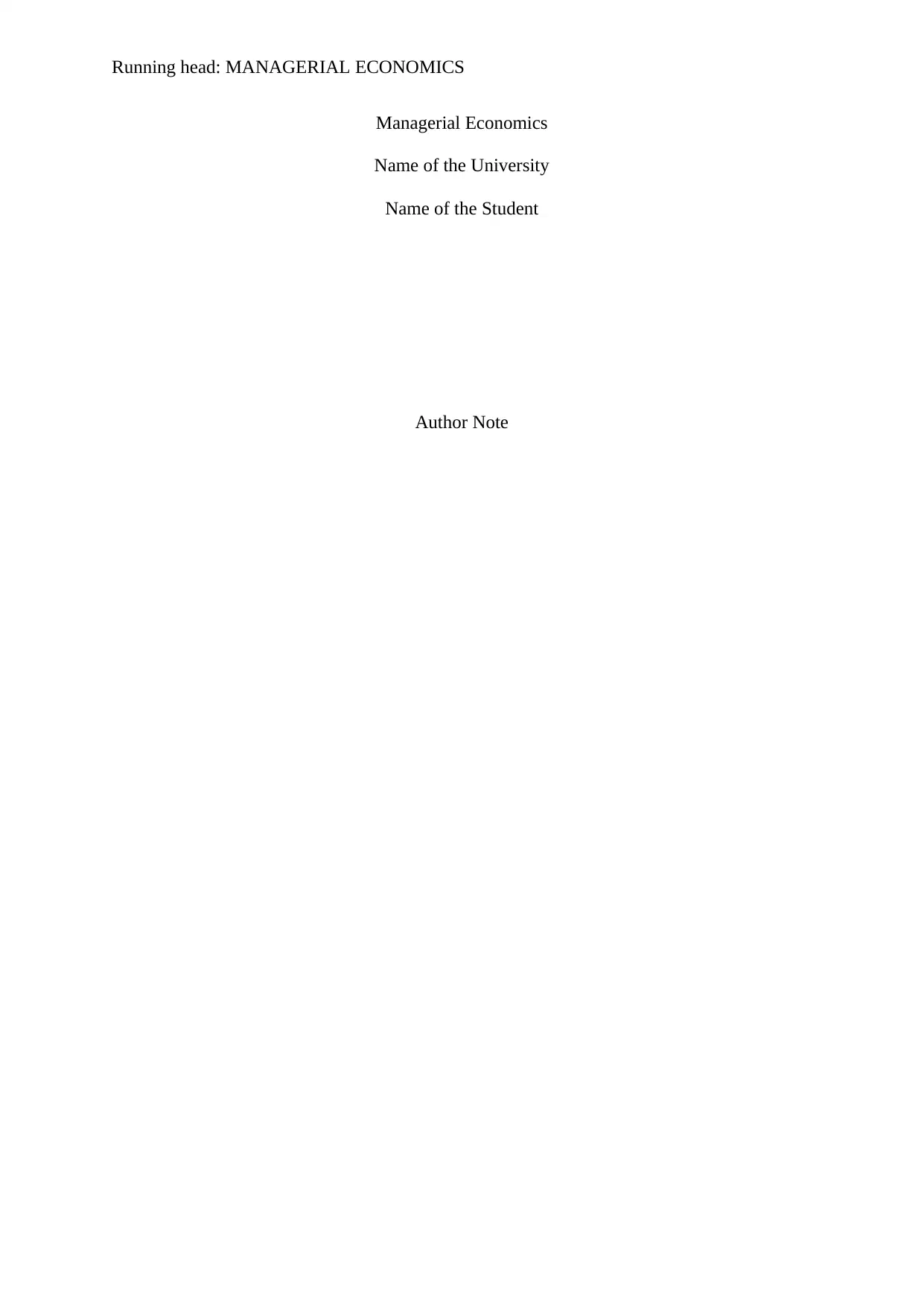
Running head: MANAGERIAL ECONOMICS
Managerial Economics
Name of the University
Name of the Student
Author Note
Managerial Economics
Name of the University
Name of the Student
Author Note
Secure Best Marks with AI Grader
Need help grading? Try our AI Grader for instant feedback on your assignments.
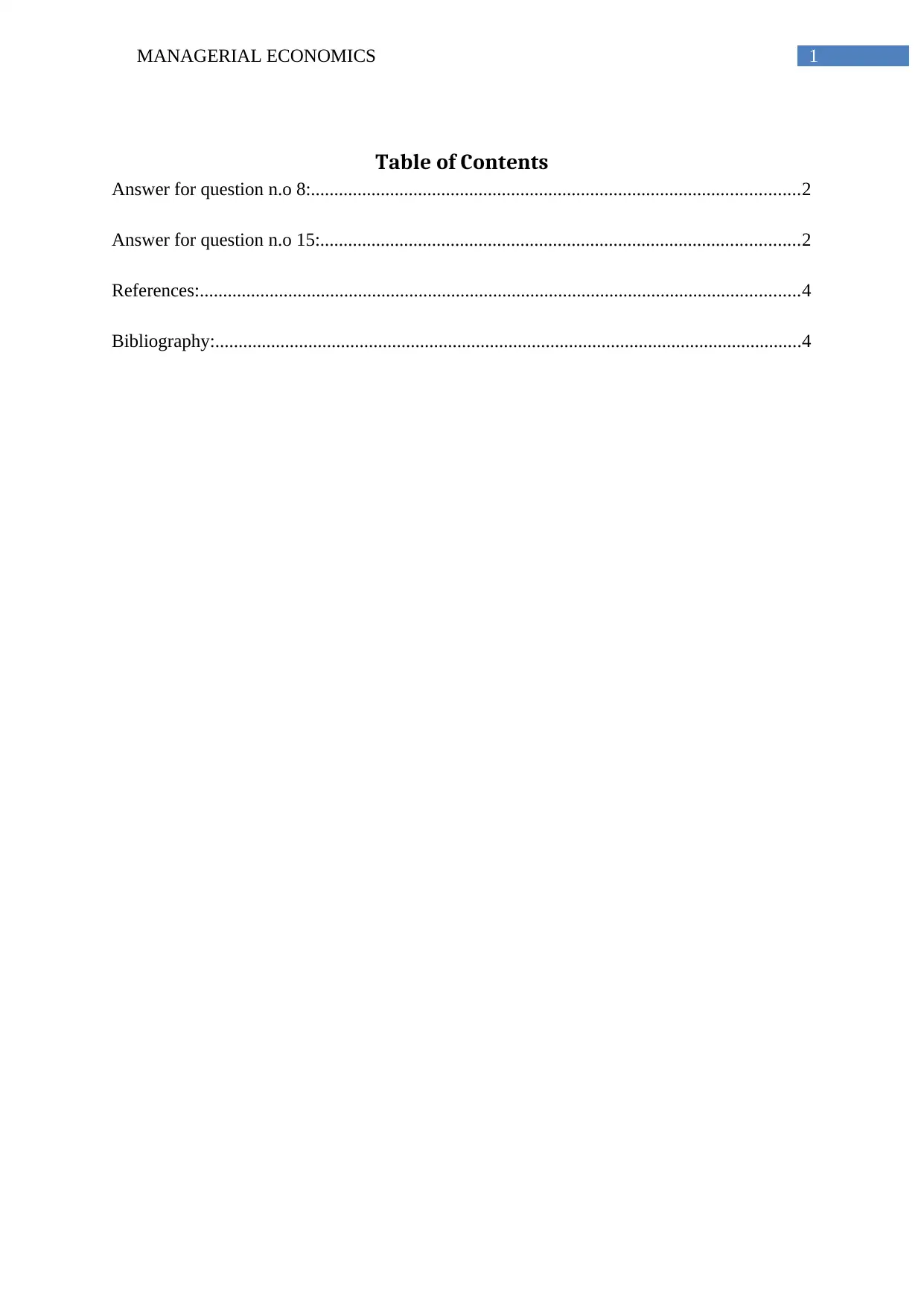
1MANAGERIAL ECONOMICS
Table of Contents
Answer for question n.o 8:.........................................................................................................2
Answer for question n.o 15:.......................................................................................................2
References:.................................................................................................................................4
Bibliography:..............................................................................................................................4
Table of Contents
Answer for question n.o 8:.........................................................................................................2
Answer for question n.o 15:.......................................................................................................2
References:.................................................................................................................................4
Bibliography:..............................................................................................................................4
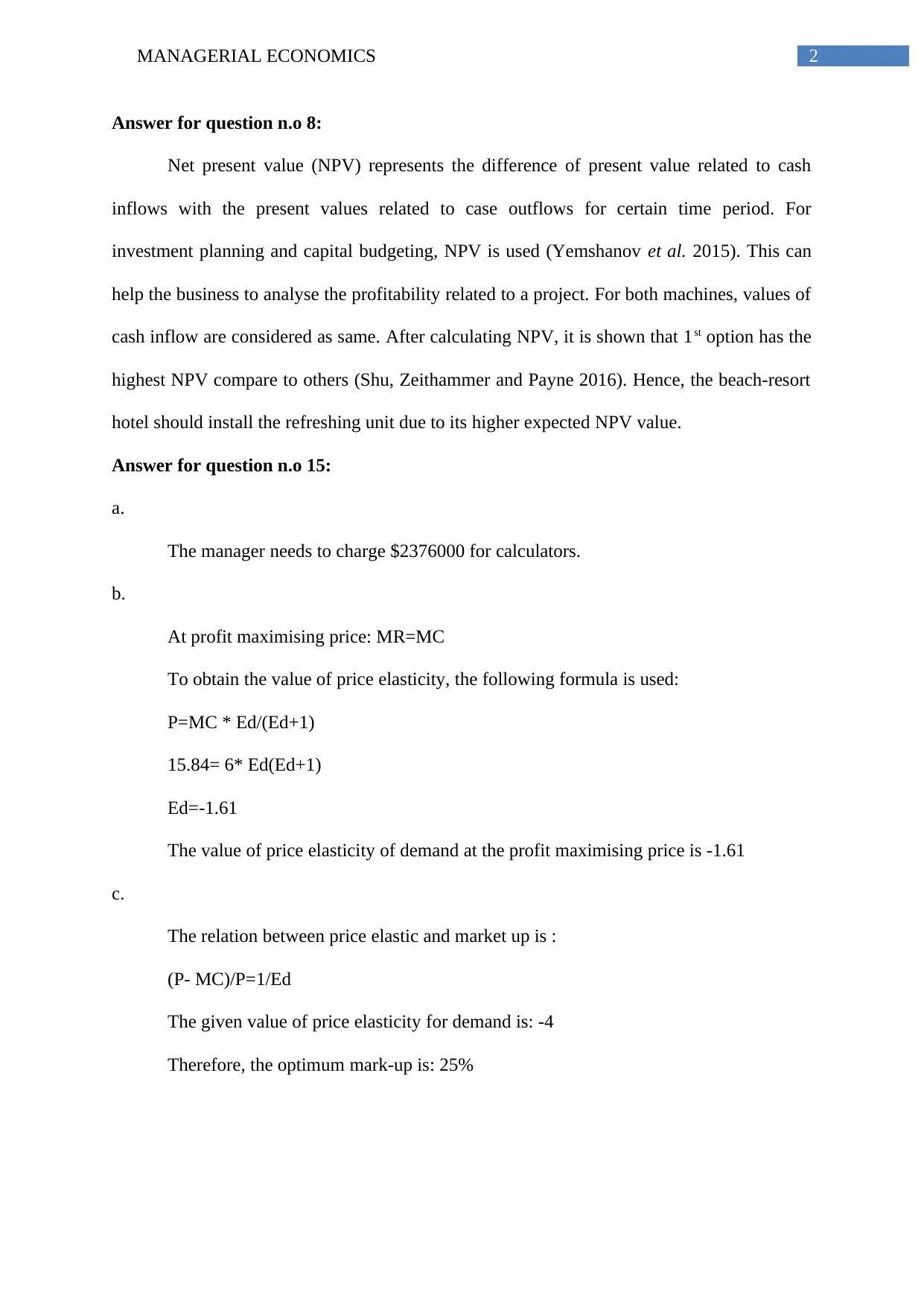
2MANAGERIAL ECONOMICS
Answer for question n.o 8:
Net present value (NPV) represents the difference of present value related to cash
inflows with the present values related to case outflows for certain time period. For
investment planning and capital budgeting, NPV is used (Yemshanov et al. 2015). This can
help the business to analyse the profitability related to a project. For both machines, values of
cash inflow are considered as same. After calculating NPV, it is shown that 1st option has the
highest NPV compare to others (Shu, Zeithammer and Payne 2016). Hence, the beach-resort
hotel should install the refreshing unit due to its higher expected NPV value.
Answer for question n.o 15:
a.
The manager needs to charge $2376000 for calculators.
b.
At profit maximising price: MR=MC
To obtain the value of price elasticity, the following formula is used:
P=MC * Ed/(Ed+1)
15.84= 6* Ed(Ed+1)
Ed=-1.61
The value of price elasticity of demand at the profit maximising price is -1.61
c.
The relation between price elastic and market up is :
(P- MC)/P=1/Ed
The given value of price elasticity for demand is: -4
Therefore, the optimum mark-up is: 25%
Answer for question n.o 8:
Net present value (NPV) represents the difference of present value related to cash
inflows with the present values related to case outflows for certain time period. For
investment planning and capital budgeting, NPV is used (Yemshanov et al. 2015). This can
help the business to analyse the profitability related to a project. For both machines, values of
cash inflow are considered as same. After calculating NPV, it is shown that 1st option has the
highest NPV compare to others (Shu, Zeithammer and Payne 2016). Hence, the beach-resort
hotel should install the refreshing unit due to its higher expected NPV value.
Answer for question n.o 15:
a.
The manager needs to charge $2376000 for calculators.
b.
At profit maximising price: MR=MC
To obtain the value of price elasticity, the following formula is used:
P=MC * Ed/(Ed+1)
15.84= 6* Ed(Ed+1)
Ed=-1.61
The value of price elasticity of demand at the profit maximising price is -1.61
c.
The relation between price elastic and market up is :
(P- MC)/P=1/Ed
The given value of price elasticity for demand is: -4
Therefore, the optimum mark-up is: 25%
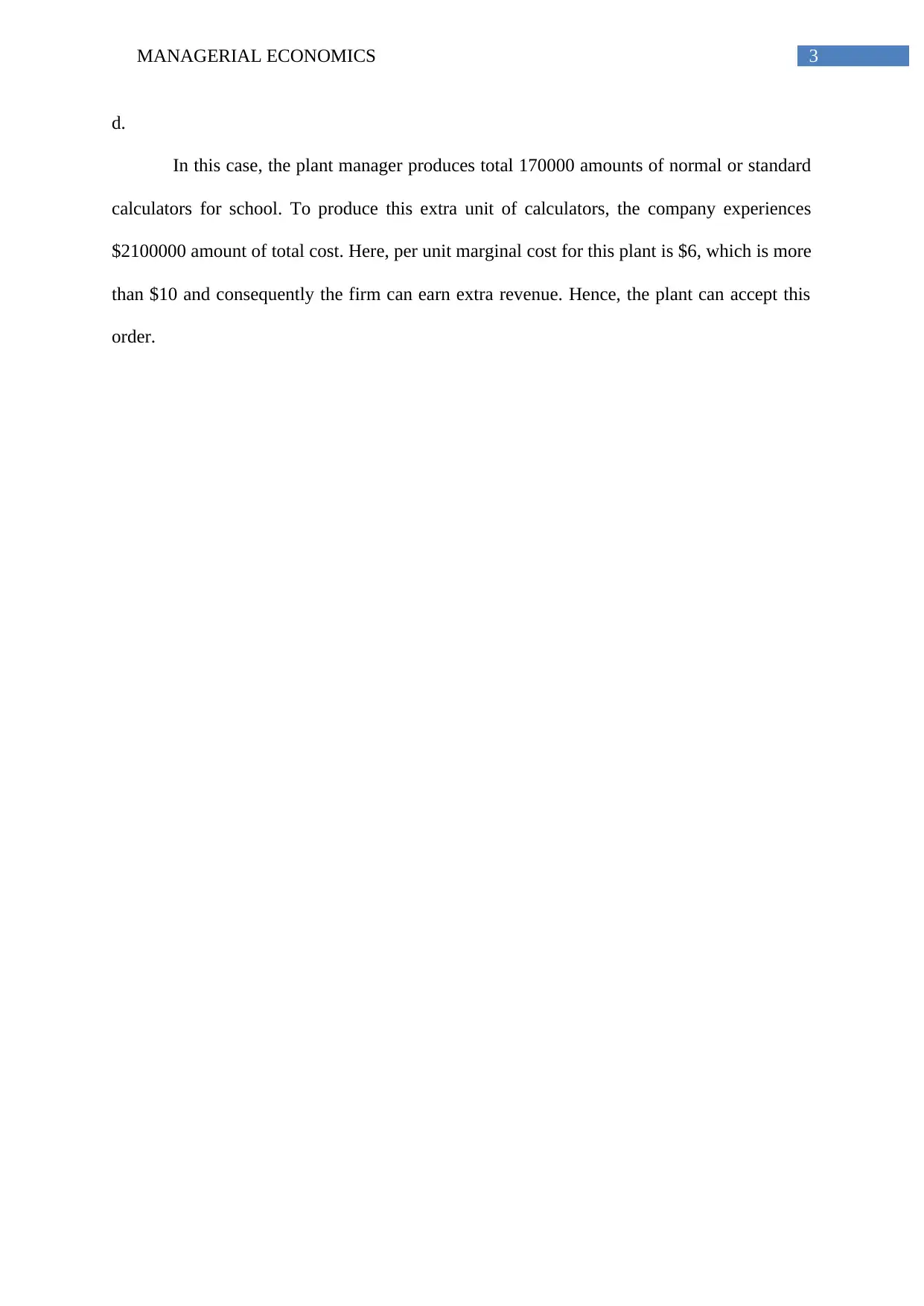
3MANAGERIAL ECONOMICS
d.
In this case, the plant manager produces total 170000 amounts of normal or standard
calculators for school. To produce this extra unit of calculators, the company experiences
$2100000 amount of total cost. Here, per unit marginal cost for this plant is $6, which is more
than $10 and consequently the firm can earn extra revenue. Hence, the plant can accept this
order.
d.
In this case, the plant manager produces total 170000 amounts of normal or standard
calculators for school. To produce this extra unit of calculators, the company experiences
$2100000 amount of total cost. Here, per unit marginal cost for this plant is $6, which is more
than $10 and consequently the firm can earn extra revenue. Hence, the plant can accept this
order.
Secure Best Marks with AI Grader
Need help grading? Try our AI Grader for instant feedback on your assignments.
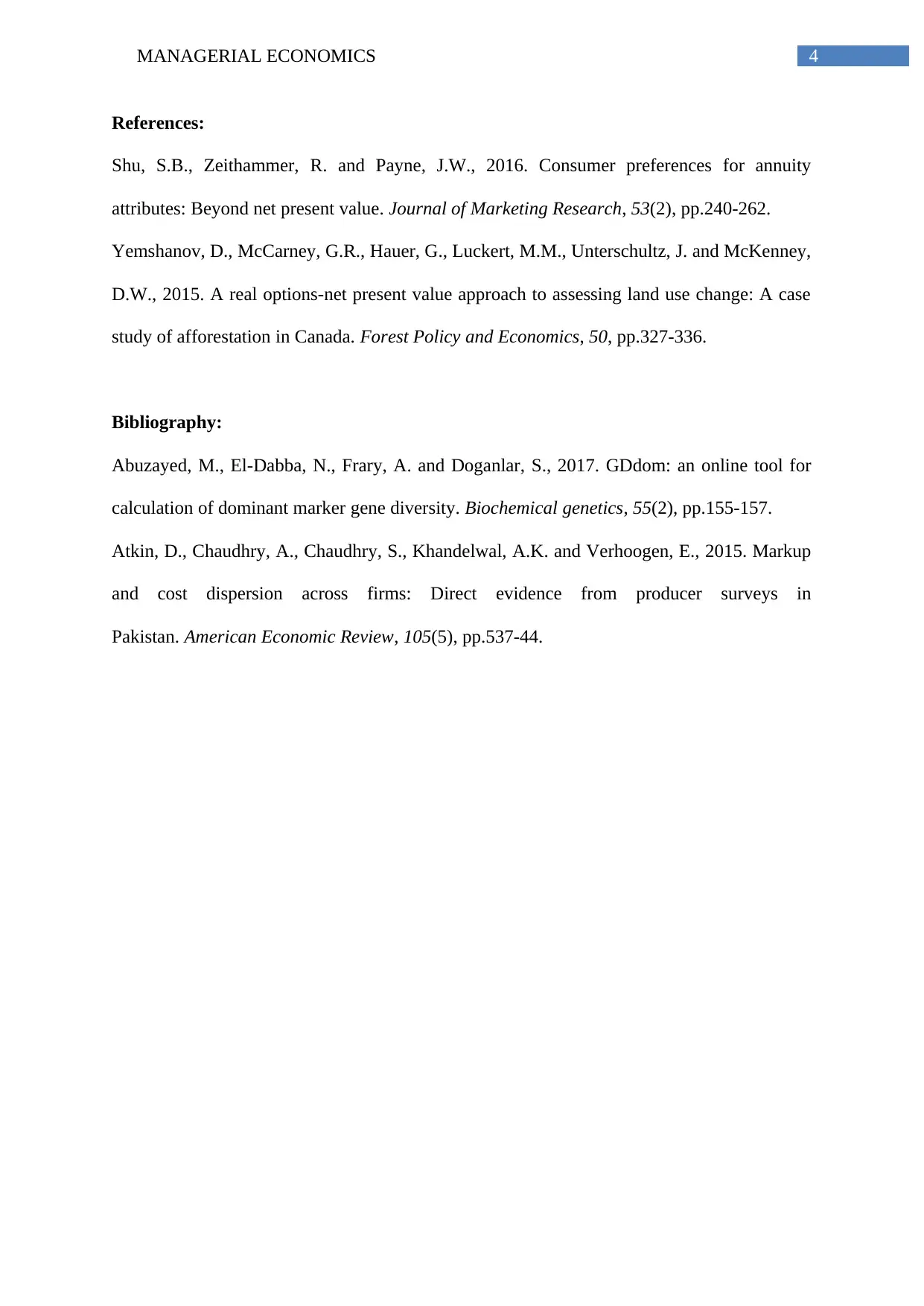
4MANAGERIAL ECONOMICS
References:
Shu, S.B., Zeithammer, R. and Payne, J.W., 2016. Consumer preferences for annuity
attributes: Beyond net present value. Journal of Marketing Research, 53(2), pp.240-262.
Yemshanov, D., McCarney, G.R., Hauer, G., Luckert, M.M., Unterschultz, J. and McKenney,
D.W., 2015. A real options-net present value approach to assessing land use change: A case
study of afforestation in Canada. Forest Policy and Economics, 50, pp.327-336.
Bibliography:
Abuzayed, M., El-Dabba, N., Frary, A. and Doganlar, S., 2017. GDdom: an online tool for
calculation of dominant marker gene diversity. Biochemical genetics, 55(2), pp.155-157.
Atkin, D., Chaudhry, A., Chaudhry, S., Khandelwal, A.K. and Verhoogen, E., 2015. Markup
and cost dispersion across firms: Direct evidence from producer surveys in
Pakistan. American Economic Review, 105(5), pp.537-44.
References:
Shu, S.B., Zeithammer, R. and Payne, J.W., 2016. Consumer preferences for annuity
attributes: Beyond net present value. Journal of Marketing Research, 53(2), pp.240-262.
Yemshanov, D., McCarney, G.R., Hauer, G., Luckert, M.M., Unterschultz, J. and McKenney,
D.W., 2015. A real options-net present value approach to assessing land use change: A case
study of afforestation in Canada. Forest Policy and Economics, 50, pp.327-336.
Bibliography:
Abuzayed, M., El-Dabba, N., Frary, A. and Doganlar, S., 2017. GDdom: an online tool for
calculation of dominant marker gene diversity. Biochemical genetics, 55(2), pp.155-157.
Atkin, D., Chaudhry, A., Chaudhry, S., Khandelwal, A.K. and Verhoogen, E., 2015. Markup
and cost dispersion across firms: Direct evidence from producer surveys in
Pakistan. American Economic Review, 105(5), pp.537-44.
1 out of 5
Your All-in-One AI-Powered Toolkit for Academic Success.
+13062052269
info@desklib.com
Available 24*7 on WhatsApp / Email
![[object Object]](/_next/static/media/star-bottom.7253800d.svg)
Unlock your academic potential
© 2024 | Zucol Services PVT LTD | All rights reserved.
